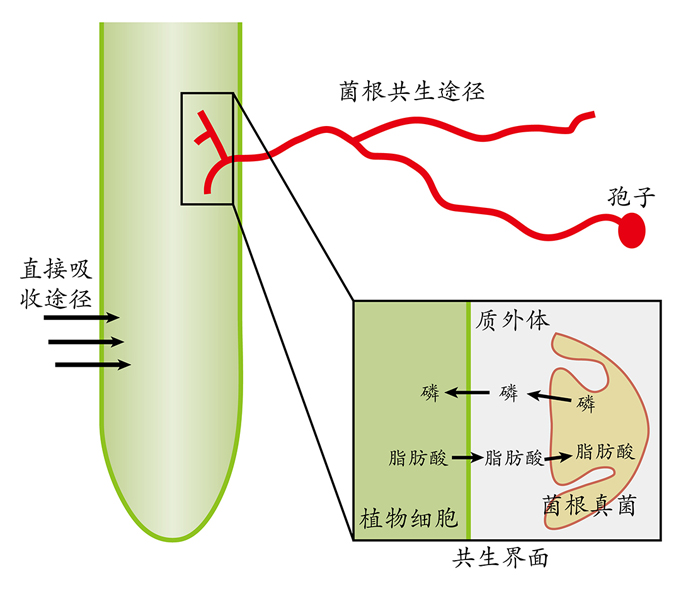

Managing Both Internal and Foreign Affairs—A PHR-centered Gene Network Regulates Plant-mycorrhizal Symbiosis
Received date: 2021-10-12
Accepted date: 2021-10-18
Online published: 2021-10-26
Phosphorus is a macronutrient essential for plant growth and development, however, phosphate (Pi), the major form of phosphorus absorbed by plants, is quite limiting in soil. To cope with this nutritional stress, plants have evolved an array of adaptive responses, which are largely regulated by changing gene expression in response to Pi deficiency. The transcription factor, PHR1 plays a key role in regulating plant transcriptional response to Pi deficiency. Besides, most land plants can form symbiosis with arbuscular mycorrhizal (AM) fungi, through which plants can obtain Pi from soil more effectively. Recently, the research group of Ertao Wang of Center for Excellence in Molecular Plant Science, Chinese Academy of Sciences, reported that a PHR-centered gene regulatory network plays an essential role in promoting plant-AM symbiosis. Therefore, PHR not only functions in maintaining plant Pi homeostasis, but also in communicating with beneficial microorganisms in the environments, which provides another route for plants to obtain Pi from soil.

Dong Liu . Managing Both Internal and Foreign Affairs—A PHR-centered Gene Network Regulates Plant-mycorrhizal Symbiosis[J]. Chinese Bulletin of Botany, 2021 , 56(6) : 647 -650 . DOI: 10.11983/CBB21177
| [1] | Bustos R, Castrillo G, Linhares F, Puga MI, Rubio V, Pérez-Pérez J, Solano R, Leyva A, Paz-Ares J (2010). A central regulatory system largely controls transcriptional activation and repression responses to phosphate starvation in Arabidopsis. PLoS Genet 6, e1001102. |
| [2] | Dong JS, Ma GJ, Sui LQ, Wei MW, Satheesh V, Zhang RY, Ge SH, Li JK, Zhang TE, Wittwer C, Jessen HJ, Zhang HM, An GY, Chao DY, Liu D, Lei MG (2019). Inositol pyrophosphate InsP8 acts as an intracellular phos- phate signal in Arabidopsis. Mol Plant 12, 1463-1473. |
| [3] | Jiang YN, Wang WX, Xie QJ, Liu N, Liu LX, Wang DP, Zhang XW, Yang C, Chen XY, Tang DZ, Wang ET (2017). Plants transfer lipids to sustain colonization by mutualistic mycorrhizal and parasitic fungi. Science 356, 1172-1175. |
| [4] | Liu F, Wang ZY, Ren HY, Shen CJ, Li Y, Ling HQ, Wu CY, Lian XM, Wu P (2010). OsSPX1 suppresses the function of OsPHR2 in the regulation of expression of OsPT2 and phosphate homeostasis in shoots of rice. Plant J 62, 508-517. |
| [5] | López-Arredondo DL, Leyva-González MA, González- Morales SI, López-Bucio J, Herrera-Estrella L (2014). Phosphate nutrition: improving low-phosphate tolerance in crops. Annu Rev Plant Biol 65, 95-123. |
| [6] | Luginbuehl LH, Menard GN, Kurup S, Van Erp H, Radhakrishnan GV, Breakspear A, Oldroyd GED, Eastmond PJ (2017). Fatty acids in arbuscular mycorrhizal fungi are synthesized by the host plants. Science 356, 1175-1178. |
| [7] | Puga MI, Mateos I, Charukesi R, Wang ZY, Franco-Zorrilla JM, de Lorenzo L, Irigoyen ML, Masiero S, Bustos R, Rodríguez J, Leyva A, Rubio V, Sommer H, Paz-Ares J (2014). SPX1 is a phosphate-dependent inhibitor of Phosphate Starvation Response 1 in Arabidopsis. Proc Natl Acad Sci USA 111, 14947-14952. |
| [8] | Rubio V, Linhares F, Solano R, Martín AC, Iglesias J, Leyva A, Paz-Ares J (2001). A conserved MYB transcription factor involved in phosphate starvation signaling both in vascular plants and in unicellular algae. Genes Dev 15, 2122-2133. |
| [9] | Shi J, Zhao B, Zheng S, Zhang X, Wang X, Dong W, Xie Q, Gang W, Xiao Y, Chen F, Yu N, Wang E (2021). A phosphate starvation response-centered network regulates mycorrhizal symbiosis. Cell https://doi.org/10.1016/j.cell.202109.030. |
| [10] | Smith SE, Jakobsen I, Grønlund M, Smith FA (2011). Roles of arbuscular mycorrhizas in plant phosphorus nutrition: interactions between pathways of phosphorus uptake in arbuscular mycorrhizal roots have important implications for understanding and manipulating plant phosphorus acquisition. Plant Physiol 156, 1050-1057. |
| [11] | Sun LC, Song L, Zhang Y, Zheng Z, Liu D (2016). Arabidopsis PHL2 and PHR1 act redundantly as the key components of the central regulatory system controlling transcriptional responses to phosphate starvation. Plant Physiol 170, 499-514. |
| [12] | Wang P, Snijders R, Kohlen W, Liu JY, Bisseling T, Limpens E (2021). Medicago SPX1 and SPX3 regulate phosphate homeostasis, mycorrhizal colonization, and arbuscule degradation. Plant Cell doi: 10.1093/plcell/koab206. |
| [13] | Wang Z, Zheng Z, Song L, Liu D (2018). Functional charac- terization of Arabidopsis PHL4 in plant response to phosphate starvation. Front Plant Sci 9, 1432. |
| [14] | Wang ZY, Ruan WY, Shi J, Zhang L, Xiang D, Yang C, Li CY, Wu ZC, Liu Y, Yu YN, Shou HX, Mo XR, Mao CZ, Wu P (2014). Rice SPX1 and SPX2 inhibit phosphate starvation responses through interacting with PHR2 in a phosphate-dependent manner. Proc Natl Acad Sci USA 111, 14953-14958. |
| [15] | Wild R, Gerasimaite R, Jung JY, Truffault V, Pavlovic I, Schmidt A, Saiardi A, Jessen HJ, Poirier Y, Hothorn M, Mayer A (2016). Control of eukaryotic phosphate homeostasis by inositol polyphosphate sensor domains. Science 352, 986-990. |
| [16] | Zhou J, Jiao F, Wu Z, Li Y, Wang X, He X, Zhong W, Wu P (2008). OsPHR2 is involved in phosphate-starvation signaling and excessive phosphate accumulation in shoots of plants. Plant Physiol 146, 1673-1686. |
/
| 〈 |
|
〉 |